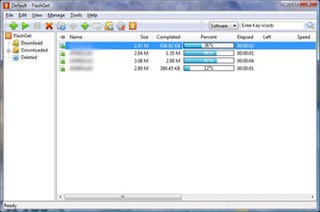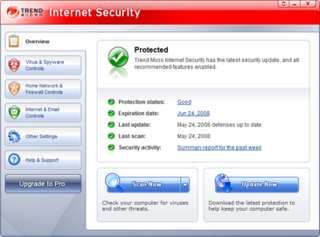Related Research Articles
A key generator (key-gen) is a computer program that generates a product licensing key, such as a serial number, necessary to activate for use of a software application. Keygens may be legitimately distributed by software manufacturers for licensing software in commercial environments where software has been licensed in bulk for an entire site or enterprise, or they may be developed and distributed illegitimately in circumstances of copyright infringement or software piracy.

Antivirus software, also known as anti-malware, is a computer program used to prevent, detect, and remove malware.

FlashGet was a freeware download manager for Microsoft Windows. It was originally available in either paid or ad-supported versions, the latter of which included an Internet Explorer Browser Helper Object (BHO).
PGPCoder or GPCode is a trojan that encrypts files on the infected computer and then asks for a ransom in order to release these files, a type of behavior dubbed ransomware or cryptovirology.
CARO is an organization that was established in 1990 to research and study malware.
RavMonE, also known as RJump, is a Trojan that opens a backdoor on computers running Microsoft Windows. Once a computer is infected, the virus allows unauthorized users to gain access to the computer's contents. This poses a security risk for the infected machine's user, as the attacker can steal personal information, and use the computer as an access point into an internal network.

The Storm Worm is a phishing backdoor Trojan horse that affects computers using Microsoft operating systems, discovered on January 17, 2007. The worm is also known as:

VirusTotal is a website created by the Spanish security company Hispasec Sistemas. Launched in June 2004, it was acquired by Google in September 2012. The company's ownership switched in January 2018 to Chronicle, a subsidiary of Google.
Koobface is a network worm that attacks Microsoft Windows, Mac OS X, and Linux platforms. This worm originally targeted users of networking websites such as Facebook, Skype, Yahoo Messenger, and email websites such as GMail, Yahoo Mail, and AOL Mail. It also targets other networking websites, such as MySpace, Twitter, and it can infect other devices on the same local network. Technical support scammers also fraudulently claim to their intended victims that they have a Koobface infection on their computer by using fake popups and using built-in Windows programs.
Swizzor is a trojan horse. This Trojan program is a Windows PE EXE file, 62 KB in size.
Alureon is a trojan and rootkit created to steal data by intercepting a system's network traffic and searching for banking usernames and passwords, credit card data, PayPal information, social security numbers, and other sensitive user data. Following a series of customer complaints, Microsoft determined that Alureon caused a wave of BSoDs on some 32-bit Microsoft Windows systems. The update, MS10-015, triggered these crashes by breaking assumptions made by the malware author(s).

Trend Micro Internet Security is an antivirus and online security program developed by Trend Micro for the consumer market. According to NSS Lab comparative analysis of software products for this market in 2014, Trend Micro Internet Security was fastest in responding to new internet threats, but as of June 2024 based on the chat support there is no known mechanism as with Microsoft Defender Antivirus to submit false positives like "Incorrectly detected as malware/malicious" or "Incorrectly detected as PUA " which may point to cutting corners and be the cause of application mislabeling e.g. as ransomware, while the mechanism for detecting real threats is not specified.
Duqu is a collection of computer malware discovered on 1 September 2011, thought by Kaspersky Labs to be related to the Stuxnet worm and to have been created by Unit 8200. Duqu has exploited Microsoft Windows's zero-day vulnerability. The Laboratory of Cryptography and System Security of the Budapest University of Technology and Economics in Hungary discovered the threat, analysed the malware, and wrote a 60-page report naming the threat Duqu. Duqu got its name from the prefix "~DQ" it gives to the names of files it creates.
Sality is the classification for a family of malicious software (malware), which infects Microsoft Windows systems files. Sality was first discovered in 2003 and has advanced to become a dynamic, enduring and full-featured form of malicious code. Systems infected with Sality may communicate over a peer-to-peer (P2P) network to form a botnet to relay spam, proxying of communications, exfiltrating sensitive data, compromising web servers and/or coordinating distributed computing tasks to process intensive tasks. Since 2010, certain variants of Sality have also incorporated rootkit functions as part of an ongoing evolution of the malware family. Because of its continued development and capabilities, Sality is considered one of the most complex and formidable forms of malware to date.
TeslaCrypt was a ransomware trojan. It is now defunct, and its master key was released by the developers.
Hupigon detected as is a backdoor Trojan. Its first known detection goes back to November 2008, according to Securelist from Kaspersky Labs.
Fileless malware is a variant of computer related malicious software that exists exclusively as a computer memory-based artifact i.e. in RAM. It does not write any part of its activity to the computer's hard drive, thus increasing its ability to evade antivirus software that incorporate file-based whitelisting, signature detection, hardware verification, pattern-analysis, time-stamping, etc., and leaving very little evidence that could be used by digital forensic investigators to identify illegitimate activity. Malware of this type is designed to work in memory, so its existence on the system lasts only until the system is rebooted.
A Trojan:Win32/Agent is the definition of a Trojan downloader, Trojan dropper, or Trojan spy. Its first known detection was January 2018, according to Microsoft Malware Protection Center. Trojans may allow an attacker to access users' personal information such as banking information, passwords, or personal identity. It can also delete a user's files or infect other devices connected to the network. It can be removed by a virus scanning and removal tool such as Microsoft Defender.
A Trojan.WinLNK.Agent is the definition from Kaspersky Labs of a Trojan downloader, Trojan dropper, or Trojan spy.
Trojan.Win32.DNSChanger is a backdoor trojan that redirects users to various malicious websites through the means of altering the DNS settings of a victim's computer. The malware strain was first discovered by Microsoft Malware Protection Center on December 7, 2006 and later detected by McAfee Labs on April 19, 2009.